Join 40,000+ sales and marketing pros who receive our weekly newsletter.
Get the most relevant, actionable digital sales and marketing insights you need to make smarter decisions faster... all in under five minutes.
Email Marketing Best Practices
- Craft a clickable subject line.
- Channel your brand identity into your messages.
- Go beyond words alone (with design and video).
- Create responsively.
- Send with a purpose.
- Send with context.
- Include an obvious call-to-action.
- Test internally.
- Segment your recipient list.
- Avoid email fatigue.
- Always be testing.
Last week I opened the promotions tab of my inbox and found 1,300 emails waiting for me.
The email marketing strategies ran the gamut — quippy subject lines promoting newsletters, urgent requests that I join a webinar, so many promises to improve my life (whether it applied to me or not).
Yeah, maybe I was procrastinating a bit, but I decided to see how many emails I could clear.
This is a total brag…
I hit inbox zero — yes, even the promotions tab — over the weekend.
There are more than 293 billion emails sent and received every day. Why did I spent a good part of my Saturday unsubscribing and deleting what felt like most of them (procrastination aside)?
Because the senders ignored email marketing best practices and did whatever they thought they could to get me to open and click.
It’s not easy being an email marketer
I get it — as marketers, we’re responsible for making sure the content we’re generating gets into the right hands. Sending email is a powerful way to reach your audience. And audiences do respond, with 59% of people admitting that marketing emails influence their purchasing decisions.
But due to this, email is often used as a crutch to blast out information to a large group of people all at once. That’s why, even though targeted messaging can work, people still dislike opening their inboxes.
The painful truth is with billions of emails crisscrossing cyberspace, those that resonate are in the vast minority. There’s just so much out there that even the mail that makes it past the spam filter — heck, even the mail that we actually signed up for — needs to stand out and immediately show its value.
So what’s a marketer to do (or not do)?
Email marketing best practices: what not to email
Here are 11 email mistakes all marketers should stop making today to improve their deliverability and click rates and make all our inboxes enormously useful.
So stop it!
1. STOP filling your subject line with click-bait
The best way to lose trust with your audience is to bait them into opening an email and then switching the offer.
At best, you’ll get a high open rate and a low click-through. At worst, you’ll confuse or anger your reader and they’ll unsubscribe.
That’s not a win for either party.
With subject lines, it’s all about the old adage: say what you’ll do and then do what you say.
You have a few options when crafting a clickable subject line (that fulfills your promises in the actual email):
- Urgency: If time is running out, say so. If your audience really needs to act soon, tell them.
What not to do: Create a FALSE sense of urgency. - Mystery: You can be a little sneaky in the subject line as long as you follow through on the reveal in the body of your email. It’s okay to promote a “major speaker announcement” in a subject line — as long as the speaker is actually a big deal and not, say, your neighbor (unless, of course, your neighbor is an A-lister).
What not to do: Tease content that doesn’t exist in the actual email. - Special deals: If I see a subject line that promotes 50% off swimsuits, I better get half off that item when I click into the email. If not, all trust (and value) is gone.
What not to do: Promote an offer that doesn’t actually exist. (Yes, you’ll get half off that swimsuit, but only in an extra-small cheetah print. Um, no.)
2. STOP emailing like it’s 1999
Twenty years ago, most people wrote emails just like they were writing letters (much akin to how your auntie ends her text messages with “Love, Aunt Pam”).
While there are still circumstances where it makes sense to use a formal tone, most marketing emails have the space to loosen up, be more creative, and get conversational.
Channel your brand identity into your messages.
Really Good Emails provides tons of examples of how brands are using tone and visuals (more on that later) to reach their audiences. And they’re also pretty good at communicating themselves. I received this webinar promotion earlier this week:
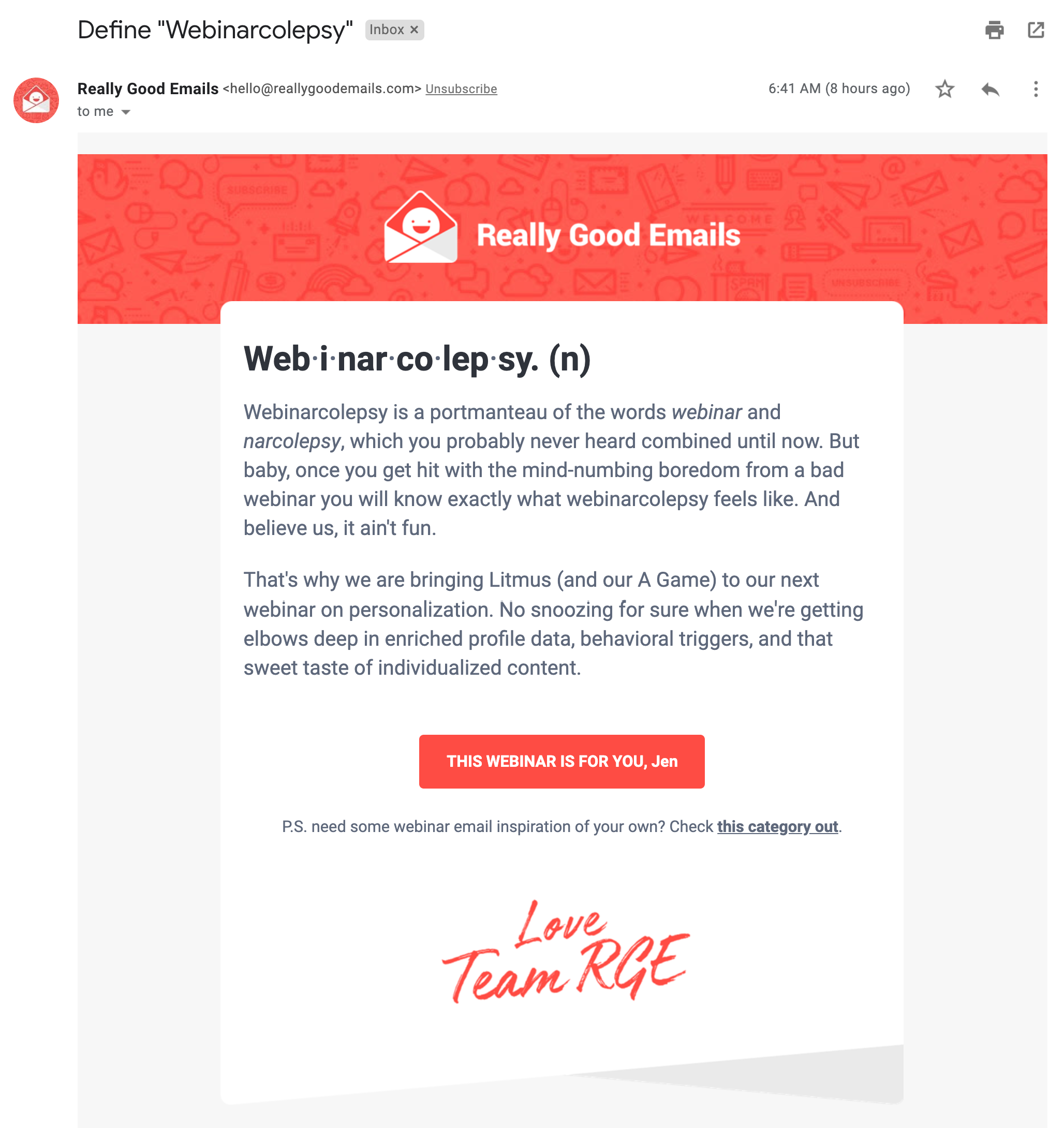
They hooked me with a weird subject line: Define “Webinarcolepsy” but then had me reading until the very end. (And I’m glad I did, otherwise, I’d miss out on the phrase “that sweet taste of individualized content.”)
This stands out from the usual “You’re invited to a webinar” banter we’ve come to expect. Plus, I have a feeling the webinar will continue in this tone and be worth attending.
Bonobos infuses its emails with a strong brand voice as well. This email’s design is patterned after an internal office memo, but the text is anything but formal.
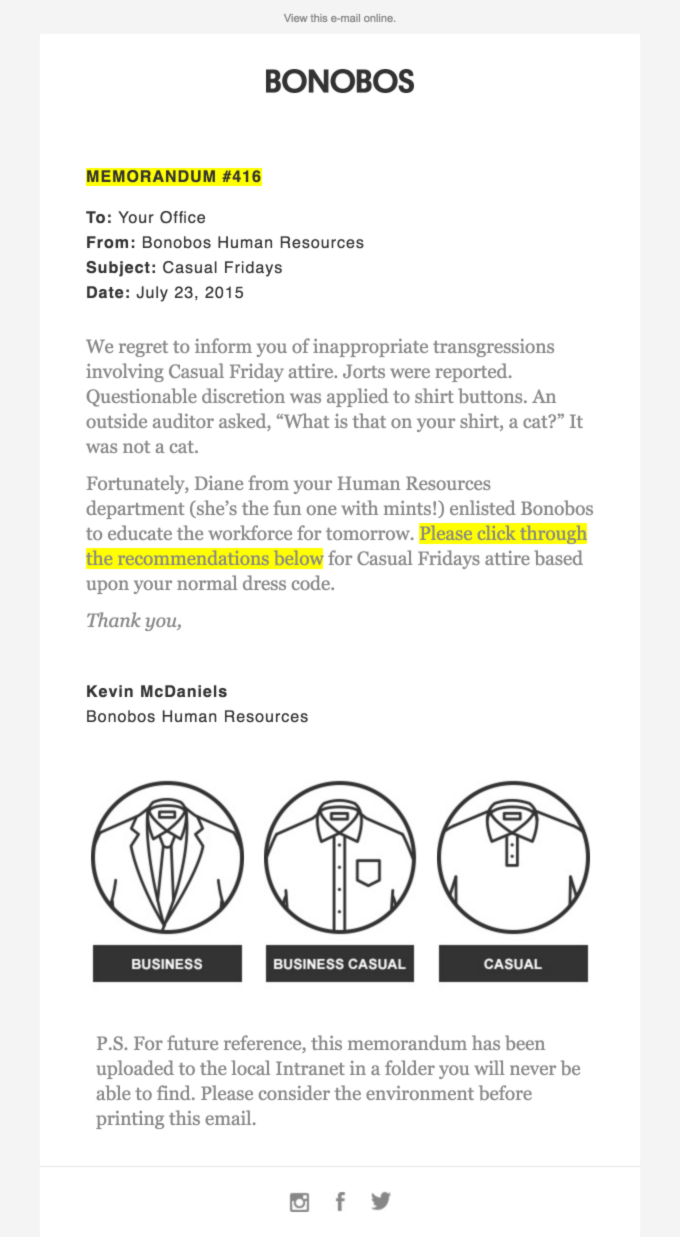
Injecting personality into your emails helps your audience better know your brand identity. The more they know about you and care about who you are, the more they’ll care about what you’re doing.
3. STOP limiting yourself to words alone
There can be much more to an email than the written word. Email design is as varied as the messages we send.
The Bonobos email above, for example, uses design to tell a story by framing the email as an internal memo.
This email from Grammarly incorporates a graphic that ties in the love theme of the subject line and body copy:
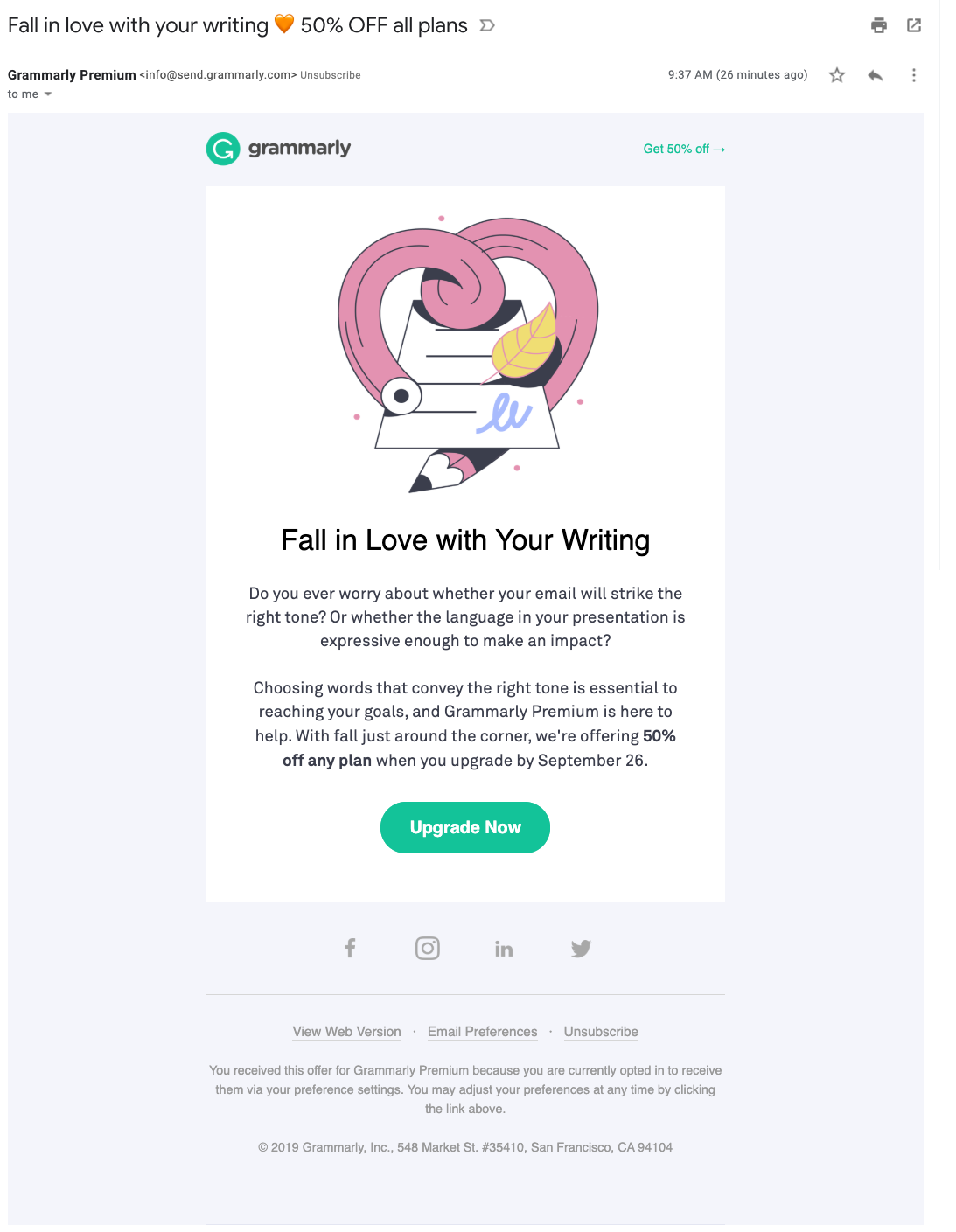
And Society6’s email dispenses with body text altogether and focuses on the products:
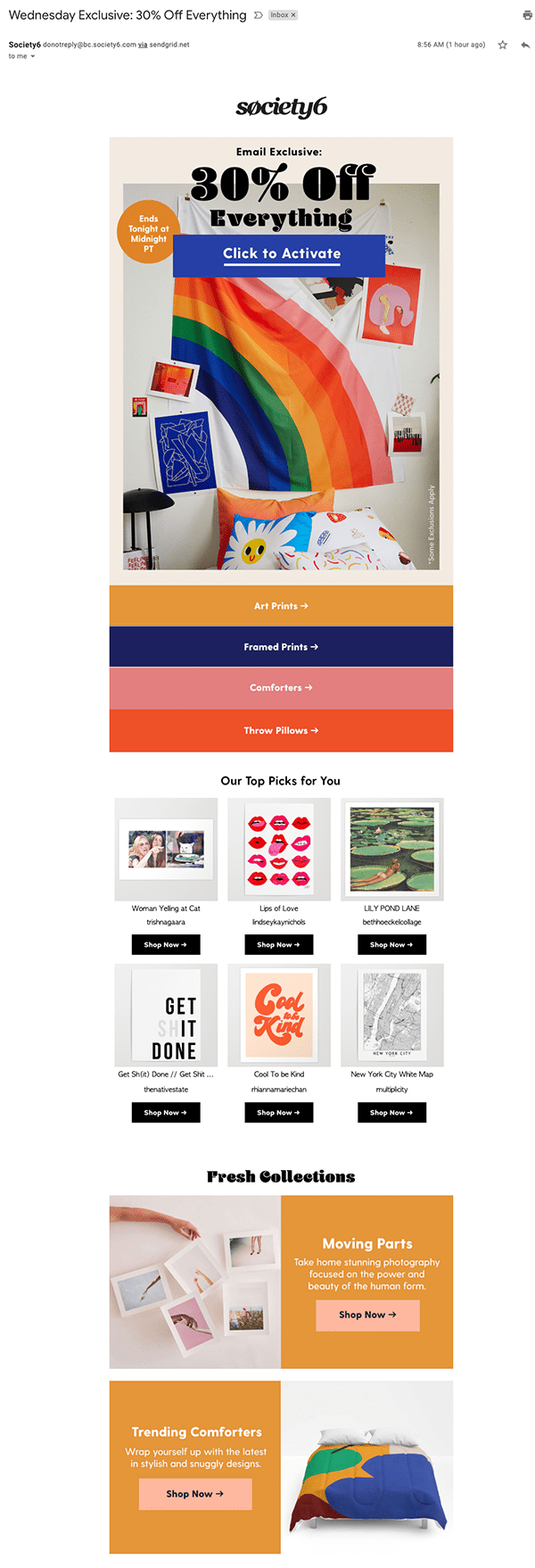
You can also stretch your emails beyond word by using video. In fact, Cisco has projected that more than 80% of all internet traffic will be video by 2021 — and, yes, that includes email.
IMPACT’s Creative Director, Alex Winter, outlined how to include video in an email campaign and the influence this can have on email marketing. Here are four quick tips he mentioned:
- Include “Video” in Your Subject Line
- Directly Embed A Video
- Draw the Eye With a Video Thumbnail
- Use an Animated GIF or Cinemagraph
4. STOP designing just for desktop
Fantastic design and informative videos won’t do anything for you if your audience has trouble viewing the email.
In the United States this year, just over 40% of internet traffic was mobile. That’s a big piece of the pie to consider when you’re designing your next email campaign.
The mobile audience isn’t forgiving about non-responsive sites either. According to Campaign Monitor, poor formatting is the number one complaint about mobile email, and emails that display incorrectly on mobile may be deleted within three seconds.
The time you’ve put into building, designing, and refining your email deserves its due. Make sure your audience can view and appreciate — and then respond to — your efforts.
5. STOP sending without a purpose
One of the biggest mistakes a marketer can make is sending spam out into the world. Make sure every email you send is sent with a purpose and not just to blast out messages for the sake of, well, blasting out messages.
There’s a debate as to whether email marketing can even be inbound, since it’s traditionally thought of as an outbound marketing effort.
Being inbound, though, requires marketers to put our customers first. It relies on our ability to know our audiences well enough to spot their questions, identify their needs, and answer them.
You can do exactly that with your email.
Only send when your audience needs something from you, not when you need something from them.
That means that your emails need to promote content that you know will help your audience.
In other words, you’re not promoting an event just to fill the room, you’re promoting it because you know your audience will learn information that will help them do their jobs better.
Be aware of what your audience is asking for and about, and then answer them. When you do that in a marketing email, you’re being as inbound-y as an email marketer can be.
6. STOP sending without context
How many times have you opened an email and thought, “Why in the world am I getting this?”
Wouldn’t it have been helpful to have the email explain it to you clearly?
Every email you send should have the value communicated to the reader quickly and clearly. If there’s any risk of them not understanding why they’re receiving messaging from you, first make sure you need to be sending them the email in the first place. Are you sending them this to help them or to help yourself? (See #5 above.)
Sometimes, however, you’re sending to a list that might be on the colder side but you still have value for them. In that case, don’t be afraid to call that out.
Be direct and let them know how they made it onto your list. Maybe they signed up in the past, or they attended a similar event, or they purchased a related product.
That honesty will reduce any skepticism your reader may have.
7. STOP assuming the reader knows what to do
I can’t think of anything worse than creating a compelling email and then not including the next step for the reader.
Make it clear what you want them to do next by including an obvious call-to-action (CTA).
The right CTA depends on the type of email you’re sending, the design, and what that next steps actually is. However, there are some best practices of CTA-building to consider:
- Make your CTA action- and benefit-oriented
- Keep your message consistent
- Provide visual contrast to stand out
- Consider location
- Always be testing
8. STOP assuming it’s good to go
See the line right above this section? Always be testing.
Always.
Be.
Testing.
Before you send your email, send test emails to yourself or others on your team to vet that everything is working correctly.
Here’s a checklist to go through before final send:
- Subject line is spelled correctly
- Preview text follow best practices
- Body copy is spelled correctly
- All hyperlinks work
- All graphics, videos, and emojis display correctly
- Email is designed in the correct template
Along with proofing the test email, you’ll need to check that the email displays correctly in various platforms. In HubSpot, that looks like this:
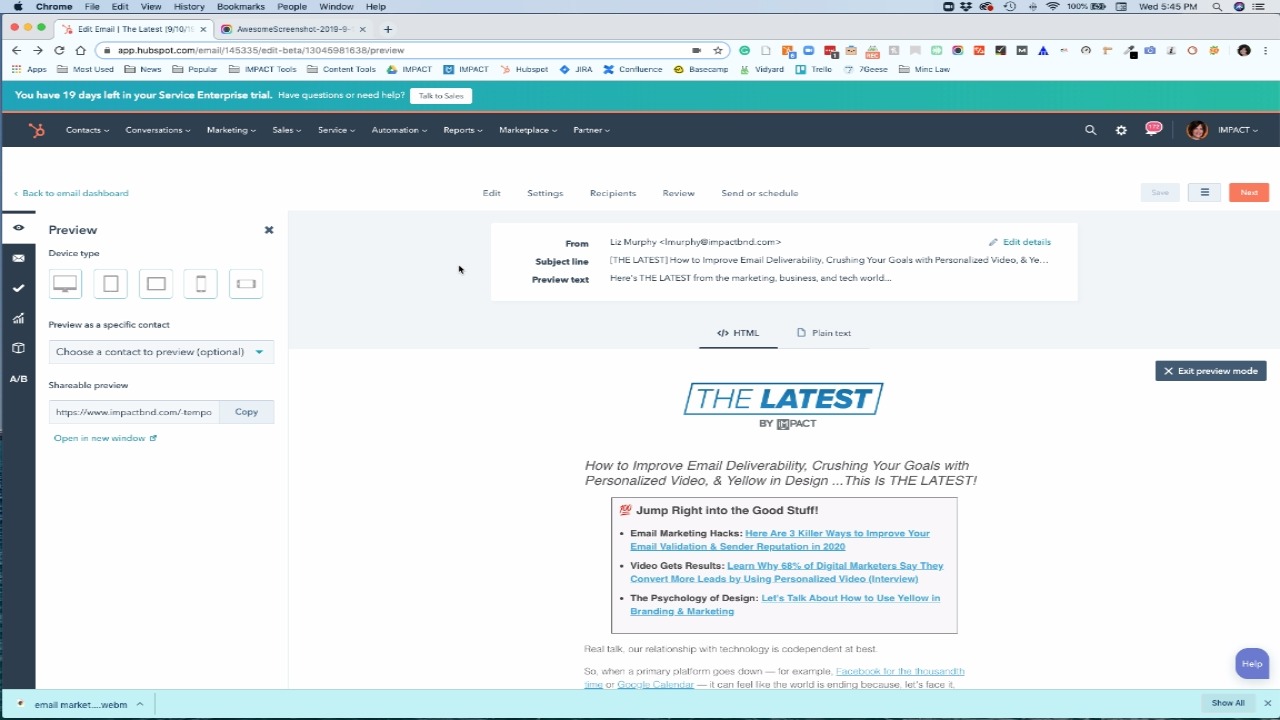
Once you confirm everything is working (and you have the right recipient list), your email is ready to send.
9. STOP sending to the wrong people
One email subject line that caught my ire lately promoted “BIG Savings!” for new members — to a club I joined three years ago. Yikes, I didn’t even have to open it to know it wasn’t for me.
This is where segmentation comes in.
Segmentation allows you to split your list of contacts into groups you can individually target.
For example:
- People who attended a specific webinar
- People who live in the midwest
- People who have joined as new members (ahem!)
Segmentation also makes it easy to map content to specific groups, so you’re sending the right material to the right people.
It pays off, too. Marketers who use segmented campaigns claim as much as a 760% increase in revenue.
10. STOP exhausting your audience
Almost 75% of Americans surveyed are overwhelmed by the number of emails they receive. (Which leaves me wondering who the other 25% are and what their inboxes look like.)
Email fatigue is real and it happens when people get tired of receiving emails ignore them, delete them, unsubscribe from them, or send them to spam.
This largely comes from either receiving too many emails from the same company or receiving irrelevant emails.
So how do you combat email fatigue?
Essentially, the answer lies in following a lot of email marketing best practices mentioned here. Start by segmenting your list (#10) and mapping the right content (#5) to the right people (#9).
Also, listen to the feedback you get. If people are unsubscribing, find out why. It could be something fixable, like making sure your design is responsive (#4). Or you could be sending too much email or sending at the wrong time.
Be aware of how your audience is reacting. The worst you can do is set and forget.
11. STOP setting and forgetting
I’ve said it before and I’ll say it forever: Always Be Testing.
If you’re not looking at your email performance metrics, then you can’t know what to tweak and test to improve your results.
As marketers, we have too many cool tools at our disposal to merely hit send, cross our fingers, and hope for a good outcome.
Before you send out your perfected email to your segmented list, send it to a test segment and look at the results. Then you can fine-tune anything that needs it before the final send. Pay special attention to the following metrics:
Delivery rate
What it is: The number of emails accepted by recipients’ servers.
What it means: A high deliverability means that your emails are making it through to the recipient’s inbox. A low rate means that your email is being blocked, usually due to having been marked as spam, not following compliance regulations, or having a poor IP reputation.
What you can do: Take steps to keep your contact list clean and make sure you’re getting permission from your recipients before sending. Due to Can-SPAM and GDPR regulations, consent is the name of the game when it comes to email send compliance.
Open rate
What it is: The percentage of people who opened the email out of those who were delivered it.
What it means: A high open rate means that your subject line resonated with your audience. A low rate means it fell flat and few people clicked to open the email.
What you can do: A/B test subject lines and continue to monitor their performance. By seeing which subject lines win out, you’ll be better able to write lines that will improve your open rates.
Click-through rate (CTR)
What it is: The percentage of people who clicked on the offer (CTA) in the email out of those who opened it.
What it means: A high CTR means that the offer presented to your audience fit their needs. A low rate means that your messaging didn’t communicate the value or that your message was sent to the wrong people.
What you can do: There are two things you can hone in on to improve your CTR: segmentation and messaging. Make sure you are targeting your audience correctly. Perhaps there’s a narrower range of people or a more specific market to target. If you're happy with your list, review your messaging. Are you clearly communicating the value of the offer? Do you have a clear CTA? Is there a better way to talk directly to your segment that would get them to click?
Conversion rate
What it is: The percentage of people who converted on or downloaded your offer out of those who opened the email.
What it means: A high conversion rate means that your email was successful and that your recipients did what you wanted them to do.
What you can do: If your CTR is high but your conversions are low, then it means you’re losing people on the landing page. Work to improve your landing page conversion if this is the case.
Hitting send
There’s so much to consider when creating an email that works. I often find that moment right as I’m about to hit the big orange “send” button to be one of the most nerve-wracking of my day. (And then, of course, right after I hit the button, I get an “Are you sure you want to send this email?” message that causes me to double-think every decision I’ve ever made. But that’s another story.)
What’s great about the process, though, is our ability to measure what works and what doesn’t and then make changes for future campaigns. A good email is a work of art — one that comes with the natural mistakes, tweaks, and lessons learned over time.
Taking the time to consider what to do (and not to do) with our emails adds to the masterpiece.
Free Assessment:

